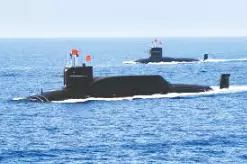‘Indian Navy deploying cutting-edge undersea surveillance network in Indian Ocean Region’

New Delhi: To further enhance its maritime defence presence, the Indian Navy is reportedly set to operationalise a state-of-the-art underwater surveillance network across major strategic areas of the Indian Ocean Region (IOR), such as the Ninety East Ridge, the Andaman and Nicobar Islands (A&N), and the Bay of Bengal. The effort, said by retired naval officials, represents one of India's strongest moves to date against China's increasing underwater presence and to protect key sea lanes amid heightened Sino-Indian naval tensions. Spanning more than 5,000 kilometers from the Bay of Bengal to the Southern Ocean, the Ninety East Ridge, an underwater chain of volcanic mountains, has become increasingly important as a possible transit route for Chinese submarines, especially nuclear-powered and conventional PLAN-operated ones. At the same time, A&N archipelago, which is home to India's sole tri-services command, holds a strategic vantage over Malacca Strait, a vital sea choke point through which over 60 percent of world trade passes and is a reported hotbed of PLAN ship activity.
Experts underlined double the Chinese submarine deployments within the IOR post-2020. Included are the silent Type 039 Yuan-class diesel-electric attack subs and nuclear-powered Type 094 Jin-class ballistic missile subs, both of which have been repeatedly seen coming close to Indian waters. The project, known as "Deep Ocean Watch," will utilize an integrated package of cutting-edge detection systems. Reports suggested that these include towed array sonars controlled from India's P-8I Poseidon maritime reconnaissance aircraft and Kolkata-class destroyers, which can passively detect the distinctive acoustic signatures of submarines. This will be supplemented by active low-frequency sonar arrays deployed along the seabed of the Ninety East Ridge, which send out pulses and listen for echoes from submerged objects. To further boost detection, the network will be equipped with Magnetic Anomaly Detectors (MAD)—airborne sensors that detect anomalies in Earth's magnetic field when large metallic objects like submarine hulls are present. Second, India is leading the introduction of Superconducting Quantum Interference Devices (SQUIDs), cryogenic sensors acutely sensitive to the weak electromagnetic signals emitted by submerged platforms. This extensive undersea surveillance web will be interwoven with India's wider Maritime Domain Awareness (MDA) framework, its satellite-monitoring capabilities as well as the Information Fusion Centre–IOR (IFC-IOR) situated in Gurugram. The IFC-IOR, with over 40 countries currently associating with it, serves as an overarching repository of maritime information as well as vessel tracking activity in the entire region.
The induction is against the backdrop of escalating local rivalry. China's fresh military base at Cambodia's Ream Naval base, which has been operational since 2024, and dual-use infrastructure projects in Myanmar's Coco Islands—just 55 kilometers from India's A&N enclave—have set regional alarm bells ringing in New Delhi. PLAN submarines have also been more frequently seen to dock at Pakistan's Karachi port, with inputs indicating possible basing rights for Yuan-class submarines, further fraying Indian nerves. Despite its technological edge, the system’s effectiveness will be tested by the Bay of Bengal’s dense maritime traffic and frequent seismic activity, both of which pose risks of false positives or misinterpretations by sensors. However, India's move is most likely to receive tacit support from a number of regional players. Vietnam and Indonesia, increasingly concerned about Chinese maritime aggression, have privately appreciated India's action. Multilaterally, allies like the United States, Japan, and Australia are likely to provide India with real-time submarine tracking data under the Indo-Pacific Maritime Domain Awareness Initiative (IPMDA). As the IOR becomes increasingly a disputed maritime border, the quiet cat-and-mouse beneath its waves could potentially set the balance of power in the Indo-Pacific region for the next several decades.



